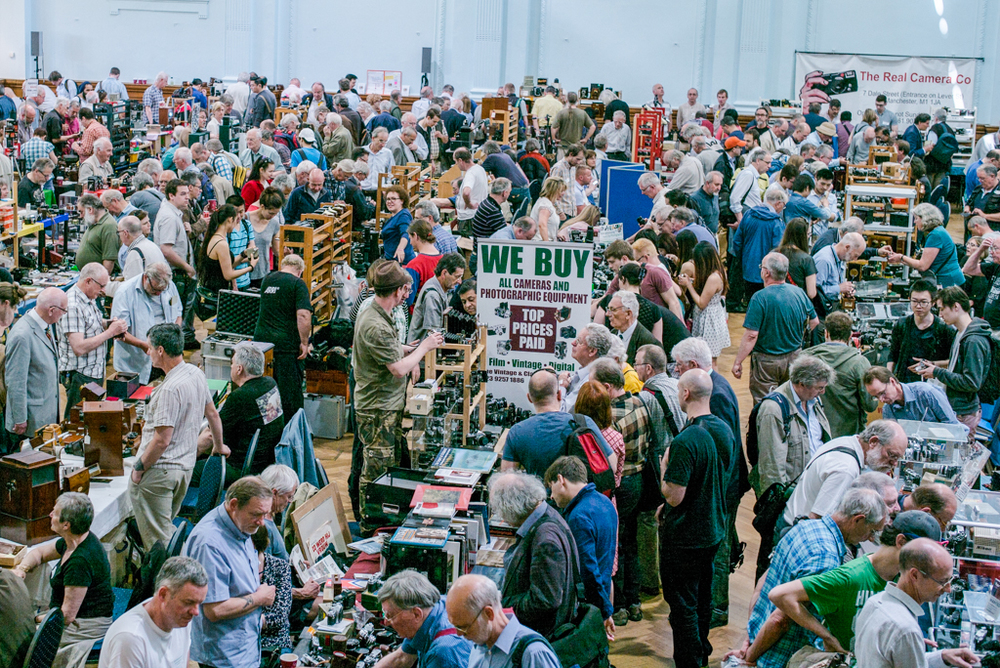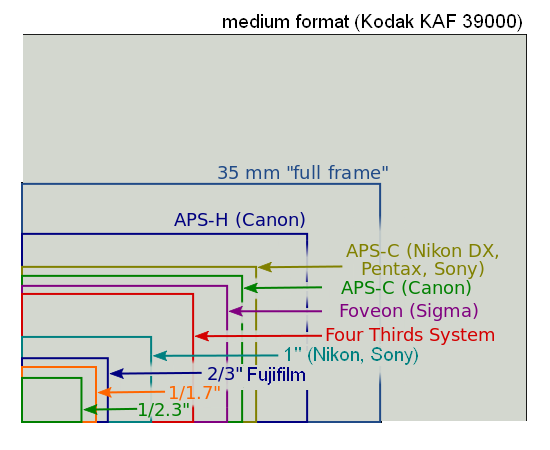How to describe a sensor with relatively more or fewer pixels? Larger, smaller? Most people do. Reader David B raised this issue when commenting on our story about the “larger” sensor that will come to the Leica Monochrom M10 in 2020.

Was I suggesting, he asked, that the new Monochrom would have a physically larger-area sensor, perhaps medium-format size? I replied that I had used “larger” in a colloquial sense, because, these days, most people do.
Many talk about a sensor with more pixels as “larger” and it is generally understood. No one would seriously infer from the article that Leica is about to squeeze a medium-format sensor into the Monochrom M10. They might assume, however, that I am loose with my choice of words. They would be right, although I did it knowingly.
I agree entirely with David B. “Larger” or “smaller” is a sloppy way of referring to the number of pixels on a sensor (except in the strict context of actual pixel size). It should be reserved for differences in sensor area, in the sense that an APS-C sensor is larger than an m4/3 sensor. Readers of many articles are left to decide what it means from the context.
Just being dense
Ideally, I would always use density as a description — because it accurately reflects reality. A 47 MP sensor is denser than a 24MP device because it crams more pixels onto the same area. It does not imply a greater area. I did use “dense” once in yesterday’s article, as an alternative description, but I am never very sure if it is accepted. I seldom see it elsewhere.

What do you think when you hear that the new version of an established camera such as the Monochrom has a “larger sensor”?
Do you imagine that it is denser in pixels or larger in area than, say, the 36x24mm dimensions of a so-called full-frame sensor?
In general, I have often avoided the term “denser” because it sounds a bit pedantic.
The world at large continues to bandy around “larger” and “smaller” and expects you to know from the context whether this means a difference in the area or the use of more pixels in the same area.
Should we establish a clear Macfilos Diktat for the future? What about restricting “larger” and “smaller” to sensor area, where they rightly belong, and adopting density to describe the number of pixels on a particular area. The alternative, I suppose, is always to spell out “with more pixels” or, as David mentions, “a greater number” or “larger number”.
He is undoubtedly right, but common usage often says otherwise, largely because alternatives are ungainly and “larger” or “smaller” is generally convenient. Using density seems to be the answer.
Or are we just being pedantic?

My head is larger than my brother’s, but I am denser than him.
I have asked him to read this post and explain it to me…. 😉
Dear Mr. Evans,
Assuming everyone says you are wrong, you could be forgiven for what you have provided us on this website. Have a good day .
Let’s not discuss the sensor
or the pixels in our pocket
fokus on das wesentliche,
See it, frame it,.. .Got it?
Leica staff have done the math
and worked it out for you
making “sehr gut” pictures
is all you have to do!
I could not agree more. My thoughts exactly.
When I opened Macfilos and saw this post my eyes glazed over and I yawned…
This afternoon I opened my iPad and Macfilos was on the screen and I scrolled down to the comments and found yours. Ah, a sane man. Good on you. Viele danke.
Hi Stephen
(and John)
I’m with you – let’s stop talking about technicalities . . .
That might seem ironic from me, but truth is that it’s what I really feel (and certainly what my wife feels 🙂 ).
best
Interesting discussion. I think higher resolution is less ambiguous and makes more sense when talking about the FF sensor in digital M cameras. I myself, am very happy with the 24MP of my M10, but I fear Leica is getting caught up in the MP War. No doubt we will have no choice but to have higher MP sensors in future M cameras.
Ok now can someone explain why that weatherization IP number is on some manufacturer cameras and not on others?
My reaction on reading the headline was ‘will the lenses cover a larger sensor’ so to me the meaning was clear but obviously not what you intended at all.
Sorry but to me it was sloppy english and misleading and indeed after reading the article I came to the conclusion it was deliberate clickbait……
Nice to see people buying real cameras with the Real Camera Company in the top right corner. This type of thing is as old as the hills with full plate, half plate, quarter plate in the 19th Century and with 10×8, 5×4, 6×9, 120, 35mm etc in the 20th Century. With plates and films you could really see the difference, but with digital it is often difficult to see the difference unless you are doing heavy crops or have a serious case of pixel peeping disease. The pixel density thing has been spoken about for some time, but, in truth, photographers are better off ignoring this and going out to take real world photos. Digital cameras have long since gone the point of ‘good enough’. This ‘pixel creep’ is largely about marketing, particularly in a stagnant market. Readers should not forget the cost of extra computing power and storage needed for more pixels.
I was very pleased with the results of a 5×4 workshop which I attended recently. The results gave away nothing to a black and white digital camera, but using the large cameras was at least 10 times the fun.
William
So true William, its more I suspect about keeping up with the Jones’s for some.
View it as tins of sardines – so we have a full frame tin size but the difference between 24mp and 47mp is just the number of sardines we have successfully crammed in to the full frame tin.
The bit I don’t understand, getting back to being sensible again. Is why are low light super beasts sensors lower in mp so the Sony A7s (I think) is 12mp. Nikon’s DF is 16mp and considered to be excellent in low light. As is the Nikon D3s with only 12mp – some people still swear by these cameras in low light over the more recent denser sensors. If they are better in low light (something I recall being larger pixel size) then why are we trying to cram more pixels in? It’s a weird conundrum that I am sure someone maybe able to better explain. Perhaps Mike there is another technical article in this alone. Not volunteering to write it either as I’m not that technically gifted.
“..they are better in low light (something I recall being larger pixel size)..” ..Exactly so. Each pixel (or ‘picture element’ or ‘photo site’) is larger than normal in those cameras (..which is why there’s a lower total number of pixels than usual..) and so they each catch more light in the same instant than smaller, more tightly-packed pixels would do. That’s why the A7S and Df are so good in low light!
“..then why are we trying to cram more pixels in?..” ..to, supposedly, get more detail in photos ..or more visible detail when you enlarge those newer multi-megapixel photos ..in other words, you can print larger without losing details – though who makes large prints nowadays, when most people look at their photos on low resolution computer, tablet or phone screens? ..But as there’s more detail (hiding) in those multi-megapixel photos – as long as you use excellent-definition lenses – that means that you can crop those multi-megapixel pictures and still have plenty of detail left ..as with, say, the 47 megapixel Leica Q2 which has a 28mm lens ..but you can crop its photos to look the same as if taken with a 75mm or 90mm lens ..and still have sufficient pixels left for the pix to look reasonably detailed!
Low pixel count for low light (A7S, Df); HIGH pixel count for high definition, allowing lots of cropping (or chopping away the edges) afterwards!
As usual cheers David for explaining this for me.
In North America, larger is always better. Anyway, I would rather be a large person than dense.
But this discussion is not about human beings.
Yes, but it was funny 🙂
“Lorraine, you are my density..” as everyone (..who’s ever seen “Back To The Future”..) knows.
I agree with Bryan; “higher resolution” immediately makes me think “more pixels” (whatever the size of the sensor), meaning, for example, 47 megapixels instead of 24 ..and probably in the same physical size of sensor.
“Greater density”, or “increased density”, Lorraine – I mean Mike – implies the same: more pixels in the same size of sensor.
“Bigger sensor” means – to me, anyway – a step up from APS to “full frame” 36x24mm, or a step up from 1″ to micro four thirds.
“Bigger car” means physically larger vehicle, and not more seats crammed into the same ‘Picasso’. But then, as I said before, maybe I’m just denser.
I say ‘higher resolution’. Density could be okay, as it can also give a connotation of pixel pitch.
Mike, I honestly thought you were referring to the area of the sensor. We have been so conditioned by all the larger is better discussions, and smaller is not worse (4/3 vs APC vs FF vs MF vs 645 vs etc). Larger cars, larger televisions, larger hair, etc all refer to physical differences in size, not increased density in the same volume. For pixels, my experience is most articles simply refer to them as more – as in “Leice M10 Monochrome to bring more pixels to the party?”.
In my opinion, there is less ambiguity when using the term ‘density’ when referencing pixel population on digital sensors. The term also has more meaning when considering the negative effects of higher densities of pixels in a prolonged working situation, such as over-heating and electronic noise. Generic terms such as large or small are relatively meaningless.